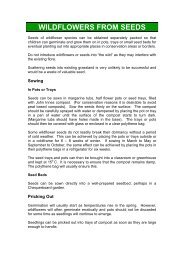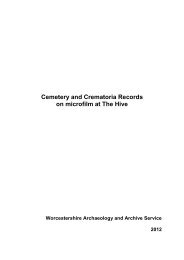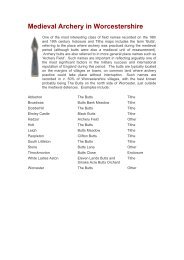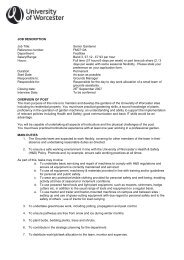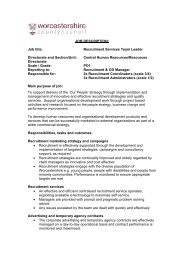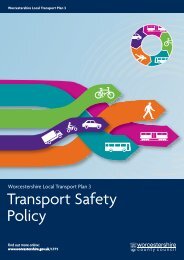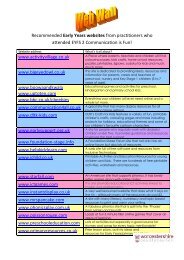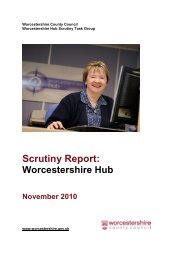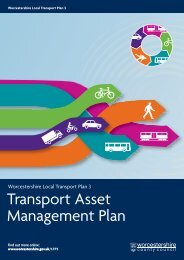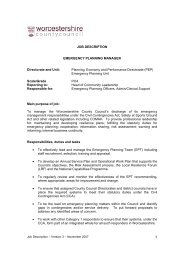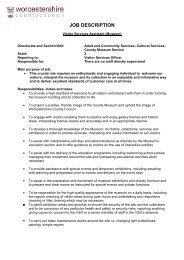Safeguarding/Child Protection Procedure for Childminders
Safeguarding/Child Protection Procedure for Childminders
Safeguarding/Child Protection Procedure for Childminders
You also want an ePaper? Increase the reach of your titles
YUMPU automatically turns print PDFs into web optimized ePapers that Google loves.
(WCC Model <strong>Safeguarding</strong> / <strong>Child</strong> <strong>Protection</strong> Policy and <strong>Procedure</strong>s<strong>for</strong> Early Years and <strong>Child</strong>care Settings)<strong>Safeguarding</strong>/<strong>Child</strong> <strong>Protection</strong> <strong>Procedure</strong> <strong>for</strong> <strong>Child</strong>minders(<strong>Child</strong>minder Name…………)Date………..Review Date………At (<strong>Child</strong>minder name……….)'s setting we follow the procedure in this flow chart, whichhas been adapted from 'What to do if you're worried a child is being abused – Summary'(DFES 2006) to include guidance from Worcestershire County Council <strong>Child</strong>ren'sServices.Flowchart 1.Referring Concerns to the Access CentreConcerns arise – records provide evidence and support discussionIf reported to assistant,DSMS (childminder)immediately in<strong>for</strong>medDSMS to determine action based on in<strong>for</strong>mation received and any additionalin<strong>for</strong>mation availableN.B Recognise factors which may influence judgement e.g. relationship with familyThresholds Guidance may support objective decision makingIt is usually good practice to discuss concerns with parents at an early stage – there may bean innocent explanation <strong>for</strong> concerns. HOWEVER - IF:Discussion with parents may put a child/an adult at greaterrisk of significant harmEvidence may indicate sexual abuse(e.g. a clear disclosure)Evidence may indicate that a crime has been committed(E.g. an injury)ALWAYS SEEK ADVICE from the Access CentreBEFORE discussing concerns with parentsAnunsatisfactoryexplanation isprovidedIn<strong>for</strong>m the Access Centre immediately: 01905 768054 Monday to Friday 8.30am to 5.00pm01905 768020 Evenings and WeekendsAll calls to the Access Centre are loggedInitially concerns may be discussed with the Access Centre as ascenario, without making a referral. The Referral and Advice Officer(RAO) will advise if a referral should be made.DSMS should Record and follow advice given In<strong>for</strong>m parents of referral if advised to do so Follow up referral to Access Centre in writing within 48 hours1The DSMS may request aprofessional conversationwith a Senior Social Workerto share concerns aboutreferral/clarify position ifnecessaryIf professional disagreementpersists, concern can beescalated to the AccessCentre Manager, and theEarly Years and <strong>Child</strong>careService Manager in<strong>for</strong>med04.2013
(WCC Model <strong>Safeguarding</strong> / <strong>Child</strong> <strong>Protection</strong> Policy and <strong>Procedure</strong>s<strong>for</strong> Early Years and <strong>Child</strong>care Settings)The Statutory Framework <strong>for</strong> the Early Years Foundation Stage (EYFS 2012) states that:A practitioner must be designated to take lead responsibility <strong>for</strong> safeguardingchildren in every setting (para 3.5)The lead practitioner is responsible <strong>for</strong> liaison with local statutory children's servicesagencies and with the Local <strong>Safeguarding</strong> <strong>Child</strong>ren's Board (para 3.5)(<strong>Child</strong>minder name………..), the lead practitioner, is referred to as the DesignatedSenior Member of staff – <strong>Safeguarding</strong> (DSMS). In the event that the DSMS isabsent.( e.g. the school run ) it is essential that all assistants understand and areable to follow this safeguarding/child protection procedure. All concerns must bereported to the Access Centre without delay(<strong>Child</strong>minder name……..) may receive an allegation about abuse of a child from achild, parent/carer, an assistant or from an outside agencyThe allegation may be verbal or written but should be treated with equal concernThe alleged perpetrator may be an adult or child. Whether they are at the setting ornot, procedures must be followed.If the alleged perpetrator is a child in the setting, that child's own safeguardingneeds must also be considered.1. At (<strong>Child</strong>minder name………….)'s setting, if the childminder or assistant(assistant to in<strong>for</strong>m DSMS) believes a child may be at risk of significant harm,e.g. because a child has disclosed possible abuse or displays an injury without aplausible explanation, they must record their concern.2. All personal and sensitive in<strong>for</strong>mation must be recorded and handled inconfidence3. The DSMS will gather any additional in<strong>for</strong>mation available and immediately followFlowchart 1. p.1. of this document, to determine actionThe DSMS will consider any factors which may affect judgement, and seekadvice from the Access Centre as necessary (including how and/or if toshare in<strong>for</strong>mation with parents/carers the child's welfare is alwaysparamount4. If a referral to children's social care is required it will be necessary to share thefollowing in<strong>for</strong>mation: The name, address, date of birth, ethnic origin and gender of the child If applicable, any disability or special need that the child may have The name of the person with parental responsibility <strong>for</strong> the child, and anyrestrictions to legal contact with the child The names and dates of birth of siblings or other children in the household (ifknown) The names and contact telephone numbers of parents and other carers orclose family members if known204.2013
(WCC Model <strong>Safeguarding</strong> / <strong>Child</strong> <strong>Protection</strong> Policy and <strong>Procedure</strong>s<strong>for</strong> Early Years and <strong>Child</strong>care Settings) The name, address and telephone number of the child's GP and Health Visitorif available The nature of the injuries observed, and/or the reason <strong>for</strong> concerns The name of the person who has raised the concern and exactly what theconcern is The parents'/carers'/child's first language5. When making the referral it is usually good practice to discuss concerns with theparents/carer first. However, if it is believed that: Discussion with parents may put the child/an adult at greater risk of harm Evidence may indicate sexual abuse (e.g. a clear disclosure) Evidence may indicate that a crime has been committed (e.g. an injury)Staff will ALWAYS SEEK ADVICE from the Access Centre BEFOREdiscussing concerns with parents/carers6. The Access Centre will advise the childminder or assistant what in<strong>for</strong>mationshould be shared with the parents/carers, if any, at this stage7. (<strong>Child</strong>minder name……….) will at all times follow instructions from the AccessCentre8. A telephone referral should be followed up in writing within 48 hourshttp://www.worcestershire.gov.uk/cms/pdf/Making-a-Referral-to-children.pdf9. If an assistant at (childminder name………….)'s setting has general concernsabout a child's welfare e.g. have logged several minor concerns over a period oftime, or have observed that a child's demeanour has changed without a plausibleexplanation, the assistant will discuss their concerns with the DSMSThe DSMS may Contact the Access Centre <strong>for</strong> further advice Recommend discussion with parents/carers Consider a Common Assessment Framework (CAF) Suggest signposting to <strong>Child</strong>ren's Centre services Continue to monitor situation10. If a referral to the Access Centre is made (childminder name…..) will follow points2–8 above11. Effective record keeping must be maintained by all staff at all times12. Within 24 hours following a referral to the Access Centre, the referrer shouldexpect to receive feedback about the course of action to be taken. The DSMS shoulddocument this and follow any instructions from the Access Centre.N.B. Assistants have a duty to escalate significant concerns to <strong>Child</strong>ren'sServices Access Centre, if their concerns about a child or another assistantare not shared by the DSMS.Supporting guidance: WSCB Thresholds Guidance <strong>for</strong> Practitioners 2011 can befound at: www.worcestershiresafeguarding.org.uk304.2013



